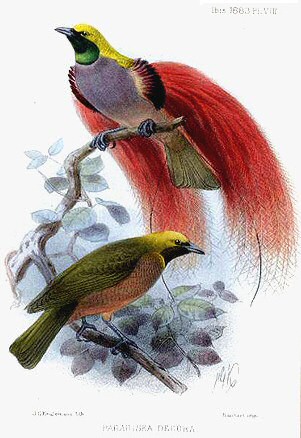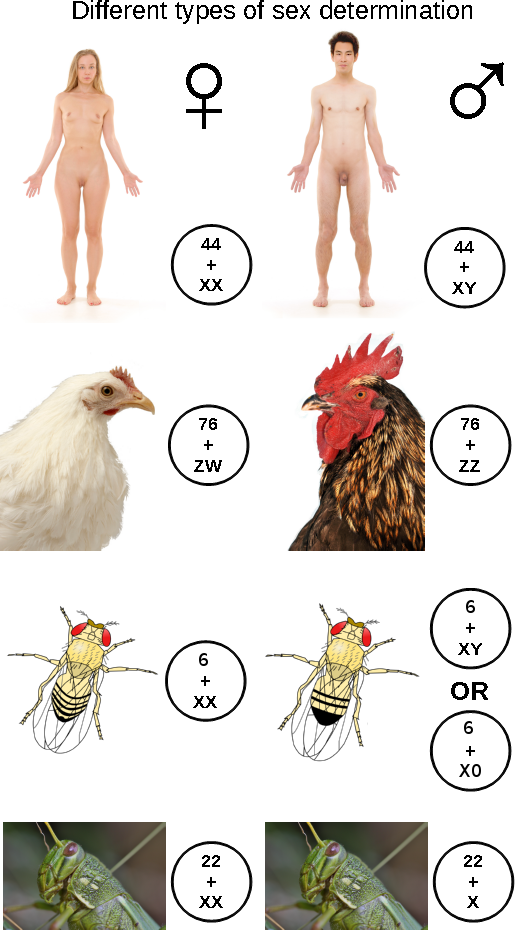|
Sex
Sex is the biological trait that determines whether a sexually reproducing organism produces male or female gametes. During sexual reproduction, a male and a female gamete fuse to form a zygote, which develops into an offspring that inherits traits from each parent. By convention, organisms that produce smaller, more mobile gametes ( spermatozoa, sperm) are called ''male'', while organisms that produce larger, non-mobile gametes ( ova, often called egg cells) are called ''female''. An organism that produces both types of gamete is hermaphrodite. In non-hermaphroditic species, the sex of an individual is determined through one of several biological sex-determination systems. Most mammalian species have the XY sex-determination system, where the male usually carries an X and a Y chromosome (XY), and the female usually carries two X chromosomes (XX). Other chromosomal sex-determination systems in animals include the ZW system in birds, and the XO system in some insect ... [...More Info...] [...Related Items...] OR: [Wikipedia] [Google] [Baidu] |
Sexual Dimorphism
Sexual dimorphism is the condition where sexes of the same species exhibit different Morphology (biology), morphological characteristics, including characteristics not directly involved in reproduction. The condition occurs in most dioecy, dioecious species, which consist of most animals and some plants. Differences may include secondary sex characteristics, size, weight, color, markings, or behavioral or cognitive traits. Male-male reproductive competition has evolved a diverse array of sexually dimorphic traits. Aggressive utility traits such as "battle" teeth and blunt heads reinforced as battering rams are used as weapons in aggressive interactions between rivals. Passive displays such as ornamental feathering or song-calling have also evolved mainly through sexual selection. These differences may be subtle or exaggerated and may be subjected to sexual selection and natural selection. The opposite of dimorphism is ''monomorphism'', when both biological sexes are phenotype, ... [...More Info...] [...Related Items...] OR: [Wikipedia] [Google] [Baidu] |
Sexual Selection
Sexual selection is a mechanism of evolution in which members of one sex mate choice, choose mates of the other sex to mating, mate with (intersexual selection), and compete with members of the same sex for access to members of the opposite sex (intrasexual selection). These two forms of selection mean that some individuals have greater reproductive success than others within a population, for example because they are more Animal sexual behaviour, attractive or prefer more attractive partners to produce offspring. Successful males benefit from frequent mating and monopolizing access to one or more fertile females. Females can maximise the return on the energy they invest in reproduction by selecting and mating with the best males. The concept was first articulated by Charles Darwin who wrote of a "second agency" other than natural selection, in which competition between mate candidates could lead to speciation. The theory was given a mathematical basis by Ronald Fisher in the e ... [...More Info...] [...Related Items...] OR: [Wikipedia] [Google] [Baidu] |
Sex-determination System
A sex-determination system is a biological system that determines the development of sexual characteristics in an organism. Most organisms that create their offspring using sexual reproduction have two common sexes, males and females, and in other species, there are hermaphrodites, organisms that can function reproductively as either female or male, or both. There are also some species in which only one sex is present, temporarily or permanently. This can be due to parthenogenesis, the act of a female reproducing without fertilization. In some plants or algae the gametophyte stage may reproduce itself, thus producing more individuals of the same sex as the parent. In some species, sex determination is genetic: males and females have different alleles or even different genes that specify their sexual morphology. In animals this is often accompanied by chromosomal differences, generally through combinations of XY, ZW, XO, ZO chromosomes, or haplodiploidy. The sexual di ... [...More Info...] [...Related Items...] OR: [Wikipedia] [Google] [Baidu] |
Sexual Reproduction
Sexual reproduction is a type of reproduction that involves a complex life cycle in which a gamete ( haploid reproductive cells, such as a sperm or egg cell) with a single set of chromosomes combines with another gamete to produce a zygote that develops into an organism composed of cells with two sets of chromosomes ( diploid). This is typical in animals, though the number of chromosome sets and how that number changes in sexual reproduction varies, especially among plants, fungi, and other eukaryotes. In placental mammals, sperm cells exit the penis through the male urethra and enter the vagina during copulation, while egg cells enter the uterus through the oviduct. Other vertebrates of both sexes possess a cloaca for the release of sperm or egg cells. Sexual reproduction is the most common life cycle in multicellular eukaryotes, such as animals, fungi and plants. Sexual reproduction also occurs in some unicellular eukaryotes. Sexual reproduction does not occur in pro ... [...More Info...] [...Related Items...] OR: [Wikipedia] [Google] [Baidu] |
Mate Choice
Mate choice is one of the primary mechanisms under which evolution can occur. It is characterized by a "selective response by animals to particular stimuli" which can be observed as behavior.Bateson, Paul Patrick Gordon. "Mate Choice." Mate Choice, Cambridge University Press, 1985 In other words, before an animal engages with a potential mate, they first evaluate various aspects of that mate which are indicative of quality—such as the resources or phenotypes they have—and evaluate whether or not those particular Phenotypic trait, trait(s) are somehow beneficial to them. The evaluation will then incur a response of some sort. These mechanisms are a part of evolutionary change because they operate in a way that causes the qualities that are desired in a mate to be more frequently passed on to each generation over time. For example, if female peacocks desire mates who have a colourful plumage, then this trait will increase in frequency over time as male peacocks with a colourful ... [...More Info...] [...Related Items...] OR: [Wikipedia] [Google] [Baidu] |
Male
Male (Planet symbols, symbol: ♂) is the sex of an organism that produces the gamete (sex cell) known as sperm, which fuses with the larger female gamete, or Egg cell, ovum, in the process of fertilisation. A male organism cannot sexual reproduction, reproduce sexually without access to at least one ovum from a female, but some organisms can reproduce both sexually and Asexual reproduction, asexually. Most male mammals, including male humans, have a Y chromosome, which codes for the production of larger amounts of testosterone to develop male reproductive organs. In humans, the word ''male'' can also be used to refer to gender, in the social sense of gender role or gender identity. Overview The existence of separate sexes has evolved independently at different times and in different lineage (evolution), lineages, an example of convergent evolution. The repeated pattern is sexual reproduction in isogamy, isogamous species with two or more mating types with gametes of identic ... [...More Info...] [...Related Items...] OR: [Wikipedia] [Google] [Baidu] |
Female
An organism's sex is female ( symbol: ♀) if it produces the ovum (egg cell), the type of gamete (sex cell) that fuses with the male gamete (sperm cell) during sexual reproduction. A female has larger gametes than a male. Females and males are results of the anisogamous reproduction system, wherein gametes are of different sizes (unlike isogamy where they are the same size). The exact mechanism of female gamete evolution remains unknown. In species that have males and females, sex-determination may be based on either sex chromosomes, or environmental conditions. Most female mammals, including female humans, have two X chromosomes. Characteristics of organisms with a female sex vary between different species, having different female reproductive systems, with some species showing characteristics secondary to the reproductive system, as with mammary glands in mammals. In humans, the word ''female'' can also be used to refer to gender in the social sense of gen ... [...More Info...] [...Related Items...] OR: [Wikipedia] [Google] [Baidu] |
Temperature-dependent Sex Determination
Temperature-dependent sex determination (TSD) is a type of environmental sex determination in which the temperatures experienced during embryonic/larval development determine the sex of the offspring. It is observed in reptiles and teleost fish, with some reports of it occurring in species of shrimp. TSD differs from the chromosomal sex-determination systems common among vertebrates. It is the most studied type of environmental sex determination (ESD). Some other conditions, e.g. density, pH, and environmental background color, are also observed to alter sex ratio, which could be classified either as temperature-dependent sex determination or temperature-dependent sex differentiation, depending on the involved mechanisms. As sex-determining mechanisms, TSD and genetic sex determination (GSD) should be considered in an equivalent manner, which can lead to reconsidering the status of fish species that are claimed to have TSD when submitted to extreme temperatures instead of the temp ... [...More Info...] [...Related Items...] OR: [Wikipedia] [Google] [Baidu] |
XY Sex-determination System
The XY sex-determination system is a sex-determination system present in many mammals (including humans), some insects (''Drosophila''), some snakes, some fish (guppy, guppies), and some plants (''Ginkgo'' tree). In this system, the sex of an individual usually is determined by a pair of Allosome, sex chromosomes. Typically, females have two of the same kind of sex chromosome (XX), and are called the homogametic sex. Males typically have two different kinds of sex chromosomes (XY), and are called the heterogametic sex. In humans, the presence of the Y chromosome is responsible for triggering male development; in the absence of the Y chromosome, the fetus will undergo female development. In most species with XY sex determination, an organism must have at least one X chromosome in order to survive. The XY system contrasts in several ways with the ZW sex-determination system found in birds, some insects, many reptiles, and various other animals, in which the heterogametic sex is ... [...More Info...] [...Related Items...] OR: [Wikipedia] [Google] [Baidu] |
Y Chromosome
The Y chromosome is one of two sex chromosomes in therian mammals and other organisms. Along with the X chromosome, it is part of the XY sex-determination system, in which the Y is the sex-determining chromosome because the presence of the Y chromosome causes offspring produced in sexual reproduction to be of male sex. In mammals, the Y chromosome contains the SRY gene, which triggers development of male gonads. The Y chromosome is passed only from male parents to male offspring. Overview Discovery The Y chromosome was identified as a sex-determining chromosome by Nettie Stevens at Bryn Mawr College in 1905 during a study of the mealworm ''Tenebrio molitor''. Edmund Beecher Wilson independently discovered the same mechanisms the same year, working with Hemiptera. Stevens proposed that chromosomes always existed in pairs and that the smaller chromosome (now labelled "Y") was the pair of the X chromosome discovered in 1890 by Hermann Henking. She realized that th ... [...More Info...] [...Related Items...] OR: [Wikipedia] [Google] [Baidu] |
Environmental Sex Determination
Environmental sex determination is the Sex-determination system, establishment of sex by a non-genetic cue, such as nutrient availability, experienced within a discrete period after fertilization. Environmental factors which often influence sex determination during development or sexual maturation include light intensity and photoperiod, temperature, nutrient availability, and pheromones emitted by surrounding plants or animals. This is in contrast to genotypic sex determination, which establishes sex at fertilization by genetic factors such as sex chromosomes. Under true environmental sex determination, once sex is determined, it is fixed and cannot be switched again. Environmental sex determination is different from some forms of sequential hermaphroditism in which the sex is determined flexibly after fertilization throughout the organism’s life. Adaptive significance Environmental sex determination is similar to certain forms of sexual selection in that there are oftentimes ... [...More Info...] [...Related Items...] OR: [Wikipedia] [Google] [Baidu] |



